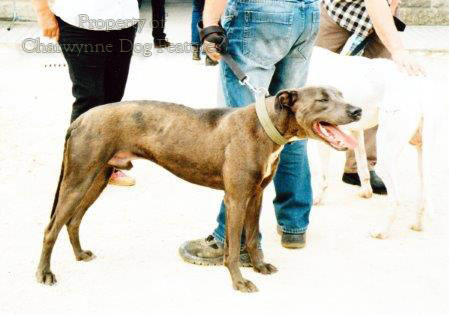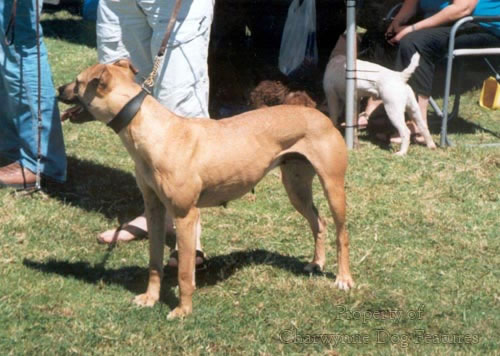421 Fit Dogs
FIT FOR THE CHOP?
by David Hancock
 It is fair to state, I believe, that the fittest dogs in Britain are the hounds of the packs, trail hounds, coursing and racing Greyhounds, working sheepdogs and some working gundogs. Coming close on their heels, and in my view, greatly misjudged by many, is the 'Irish Staffie' fraternity. Maligned in the popular press, misunderstood by some pedigree dog breeders and vilified by one animal charity in a malicious press release, they deserve praise and encouragement not condemnation. Of course, in any field of human activity, there will be those who will abuse a sport, a fancy, a hobby or a calling. Decent honourable people in any walk of life need to be vigilant in spotting human excess. Abuse of dogs is, sadly, not rare and I strongly support exposure and punishment of it.
It is fair to state, I believe, that the fittest dogs in Britain are the hounds of the packs, trail hounds, coursing and racing Greyhounds, working sheepdogs and some working gundogs. Coming close on their heels, and in my view, greatly misjudged by many, is the 'Irish Staffie' fraternity. Maligned in the popular press, misunderstood by some pedigree dog breeders and vilified by one animal charity in a malicious press release, they deserve praise and encouragement not condemnation. Of course, in any field of human activity, there will be those who will abuse a sport, a fancy, a hobby or a calling. Decent honourable people in any walk of life need to be vigilant in spotting human excess. Abuse of dogs is, sadly, not rare and I strongly support exposure and punishment of it.
I sometimes attend gatherings of devotees of the so-called 'Irish Staffie' and am always struck by two aspects at them: very fit dogs and an outing for whole families who dote on their dogs. These dogs are trained on 'A' frames, treadmills and at weight-pulling; this is often demonstrated at these shows. Not surprisingly the dogs present are fit, muscular and full of vigour; they are much-loved, extremely healthy, live a long life and are admired as canine athletes. For the RSPCA however, 'A' frames, treadmills and weight-pulling 'apparatus' constitute the 'paraphernalia of dog-fighting', as their officers have described it in court.
This is a calumny; it is akin to saying that all those possessing or making use of, say, kick-boxing apparatus are preparing for a violent illegal act and should be arrested. At these 'Irish Staffie' gatherings I have never once seen a dog carrying bite marks, old scars, signs of stitching or the tell-tale consequences of dog-fighting: torn ears. Yes, some of these dogs are a bit sharp with other dogs, but I have seen working sheepdogs show far greater aggression towards other dogs without being condemned as a type. The families attending these gatherings would be furious if anyone tried to link them with dog-fighting of any type.
Why is it considered suspicious for someone to want to own a fit dog? Soon, obesity will cause more premature deaths in dogs than any other cause; is that not a form of cruelty demanding campaigns by animal charities? A survey a few years ago found that 52% of dogs in Britain were overweight and that 10% were more than 25% overweight. One Afghan Hound weighed as much as two normal Afghans. Veterinary surgeons warn us that the major threat to the long life and quality of life of dogs in this new century is posed by obesity, created partly by over or inappropriate feeding but mainly by lack of exercise. This is indirect cruelty on a grand scale. Where is the high-profile campaign against such cruelty?
The only high-profile campaign that is being conducted by our leading animal charity is aimed at the fittest dogs in the country not the fattest. Why does the alleged selective cruelty to foxes not become dwarfed by a massive campaign to counter the widespread abuse of dogs through neglect--neglect of essential exercise? Surely you concentrate scarce funds on the biggest challenge not the most emotive one. The RSPCA is said to have spent over four million pounds in the drive against hunting in one year alone; how much did the drive against obesity, which involves proven cruelty, cost? Why target fit dogs when fat dogs are suffering?
The extremely fit 'Irish Staffies' are usually disparaged by show breeders, despite the fact that these dogs are more like the early Bull Terriers than theirs. The Kennel Club could lead the way by advising judges to omit from their deliberations any exhibit not in show condition, with obesity a disqualifying fault. It is not good enough to hide behind judges, the top body in the world of pure-bred dogs should set out its stall. Under-exercised overweight dogs should not even be considered by show ring judges. This would have an enormous effect on exhibitors and do an enormous amount of good for the healthier dog movement. I have never seen a fat dog at an 'Irish Staffie' show. But I have heard anxious owners express the worry that if their dogs were seen to be fit, muscular, well-exercised and in hard condition, this would arouse the interest of the so-called Special Operations section of the RSPCA.
What a crazy concern! We now have a country in which those taking the greatest interest in the fitness of their dogs attract the greatest suspicion. If seized by this section, evidence of 'breed' would be given in court, on the RSPCA's behalf, by a veterinary surgeon, despite the Royal College of Veterinary Surgeons' firm and clear statement that a vet's training does not fit them for such a task. For how long are we going to tolerate such madness? It gets worse; a couple of years ago, in the monthly magazine Dogs Monthly, the RSPCA's Chief Veterinary Surgeon wrote: "I do not understand quite why your correspondent should consider the RSPCA guilty of currently portraying some breeds as anti-social." Where was this scientist when the Dangerous Dogs Act was drafted, naming certain breeds of dog as anti-social, and the two bodies advising the Home Office on its provisions were the Kennel Club and the RSPCA?
With fat dogs appearing at Crufts and our principal animal charity targeting fit dogs, how do we campaign against the most widespread threat to dogs -- obesity? Appeal to the dog food manufacturers? I don't think so. Appeal to the owners? Unrewarding, in my experience. Killing by kindness is not an emotive issue; it is probably condoned by the morally vain. Involve the veterinary profession? Not if the food being sold in so many surgeries these days is anything to go by. Educate the future generations? They are struggling with obesity themselves if the high street is any indicator. The 'Irish Staffie' fanciers could be forgiven for allowing their dogs to get so fat that they are no longer suspected of training them for dog fighting.
In the longer term, when any dog capable of hunting, pointing or retrieving has been put down, together with any breed or type resembling a fit Bull Terrier, and pastoral dogs are unemployed, how will anyone know what a fit dog actually looks like? At the moment few judges, and even fewer exhibitors, at shows, seem to know what hard condition, muscular development and sound movement really is. The link between the three escapes them. I once thought that shamelessness was the reason behind unfit dogs in the ring; now it is probably more due to ignorance. One day soon it will due to innocence; no one will know what a really fit dog looks like. This is very bad news for the domestic dog.
One of my great joys in life is to see a working dog in action, coat gleaming, muscles rippling, eyes bright and feet tight. For me a beautiful dog is not one standing but one moving. A supremely fit, soundly constructed dog puts little stress on its joints, expends energy economically and performs highly efficiently in its locomotion. It makes less demand on its heart and lungs. It enjoys a higher quality of life and a longer life. A well-exercised dog usually means a well-exercised owner, an additional benefit. Over use of the car may account for packed doctors' waiting rooms; it is becoming a cause of crowded vets' waiting rooms too.
Perhaps we need a special newly-created charity, dedicated to dogs, to head up a wholehearted campaign to combat obesity in dogs. Could the praiseworthy Dogs Trust be persuaded to, shall we say, take a lead? This charity had a record year in 2001, rehoming more dogs than ever before, with half its income spent on this and nothing spent on anti-dog campaigns.
But we all have a part to play in any campaign against canine obesity. Writers can extol fitness and condemn fatness. Vets can advise on diet, whatever the loss in turnover. Food manufacturers can be lobbied by the dog press to promote healthier feeding. The Kennel Club could give the highest priority to show condition and make obesity a disqualifying fault. Judges could then throw overweight exhibits out of the ring. Any self-respecting houndshow judge would react strongly if a fat hound was offered for his inspection. Conformation dog shows sprang from houndshows and should honour that heritage.
A more affluent society should mean better cared for pets not under-exercised overfed shorter-lived ones. Just as the sporting dog is under unprecedented threat from the morally vain, so is the domestic pet from unenlightened owners who need waking up. But if hard-muscled super-fit 'Irish Staffies' are not to be admired, if the entry at the showcase of Crufts happily displays obesity and the owners of fat pets are not condemned, we are undermining all the work of our predecessors in handing on superlative animals for our care. We should be eternally grateful, in this mean and nasty world, that we have the well-being of such admirable creatures as dogs, in our hands, if at our whim. It is a responsibility not to be under-rated. In times when the old expression 'as fat as a butcher's dog' has been craftily recast as 'as fit as a butcher's dog', we should ensure that we at least know the difference. Fit must never be replaced by fat!